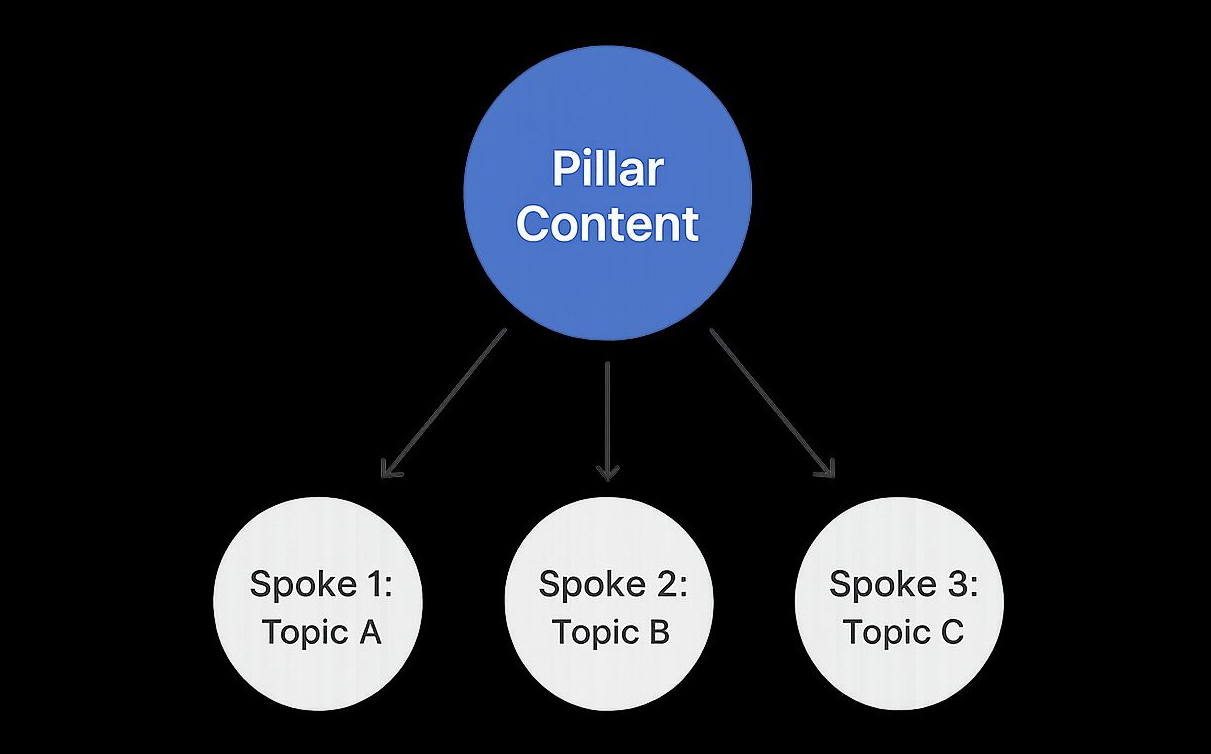Table of Contents
Dominate Your Niche: Content Strategy Examples That Work
1. Hub and Spoke Content Model
Examples of Successful Implementation
2. Content Atomization Strategy
3. Persona-Driven Content Strategy
Examples of Successful Implementation
Actionable Tips for Implementation
When and Why to Use This Approach
Features of an SEO-First Content Strategy
Examples of Successful Implementation
When and Why to Use This Approach
5. Thought Leadership Content Strategy
Benefits of a Thought Leadership Strategy
Actionable Tips for Implementing a Thought Leadership Content Strategy
When and Why to Use This Approach
6. User-Generated Content Strategy
Examples of Successful Implementation
Pros and Cons of a UGC Strategy
Tips for Implementing a UGC Strategy
7. Content Distribution Network Strategy
Features of a Robust Content Distribution Network Strategy
Examples of Successful Implementation
Dominate Your Niche: Content Strategy Examples That Work
A strong content strategy is crucial for online success.
This article provides seven proven content strategy examples to improve your marketing results.
You will learn how to attract your target audience, drive traffic, and increase conversions with approaches like the Hub and Spoke model, Content Atomization, and a Persona-Driven strategy.
Whether you're building an SEO-first strategy, establishing Thought Leadership, encouraging User-Generated Content, or optimizing your Content Distribution Network, these examples offer actionable insights for optimizing your content and achieving your business objectives.
Publish your SEO–driven content!
Visit BlogMaker.app1. Hub and Spoke Content Model
The Hub and Spoke Content Model is a powerful content strategy example that helps businesses establish thought leadership and improve their search engine optimization (SEO).
It structures content around a central, comprehensive resource, the "hub," and links it to multiple related pieces of content, the "spokes." This creates a robust content ecosystem that benefits both users and search engines. This model allows you to dive deep into a topic, offering comprehensive coverage in the hub while addressing specific nuances and related questions in the spokes.

The infographic above visualizes the hierarchical structure of the Hub and Spoke model.
The central "Content Pillar" represents the hub, acting as the primary resource. This could be an ultimate guide, a long-form blog post, or even a dedicated landing page. The surrounding spokes are individual pieces of content, like blog posts, infographics, videos, or podcasts, that expand into specific aspects of the core topic. The connecting lines represent the internal links that tie the spokes back to the hub, reinforcing its authority and providing users with clear navigation paths.
This interconnected structure has several key advantages.
First, it establishes topical authority by providing in-depth coverage of a subject matter.
Second, it improves SEO performance through strategic internal linking, signaling to search engines the importance of the hub content.
And finally, it enhances user navigation by providing clear pathways between related pieces of information.
This approach is particularly effective when you want to build a comprehensive knowledge base around a key topic relevant to your business. For example, if you're a marketing agency specializing in SEO, your hub could be an in-depth guide to SEO best practices. And your spokes could then cover specific aspects like keyword research, on-page optimization, and link building.
Examples of Successful Implementation
- HubSpot's marketing guides uses comprehensive marketing guides as hubs, linking them to relevant blog posts and other resources as spokes.
- Moz's SEO Learning Center uses main guides as hubs, supported by articles and tutorials focusing on specific SEO topics.
- Canva's Design School uses central design elements pages as hubs and links to supporting tutorials and resources as spokes.
Pros:
- Establishes topical authority
- Improves SEO through strategic internal linking
- Provides clear navigation paths for users
- Structured and strategic content planning
- Creates multiple entry points to key content
Cons:
- Requires significant planning and coordination
- Can be resource-intensive to create comprehensive hub content
- Needs ongoing maintenance to ensure links remain relevant
- May require restructuring existing content
Actionable Tips:
- Identify your main topics: Start by identifying the core topics you want to be known for.
- Create exhaustive hub content: Develop comprehensive, high-quality content for your hubs.
- Map out spoke content: Plan related content pieces that elaborate into specific aspects of the hub topic.
- Keyword research: Use keyword research to identify related topics for your spokes.
- Consistent internal linking: Ensure consistent internal linking between spokes and the hub.
- Regular updates: Update your hub content regularly to keep it current and relevant.
The Hub and Spoke Content Model deserves a prominent place in any content strategy discussion because of its effectiveness in establishing authority, improving SEO, and enhancing user experience.
By strategically planning and implementing this model, businesses can create a powerful content ecosystem that drives organic traffic, generates leads, and positions them as industry leaders. This model is especially valuable for small business owners, digital marketing professionals, and bloggers seeking a structured approach to content creation that yields tangible results.
Publish your SEO–driven content!
Visit BlogMaker.app2. Content Atomization Strategy
Content atomization is a powerful content strategy example that involves deconstructing a larger piece of content, like a blog post, white paper, or webinar, into smaller, bite-sized pieces optimized for different platforms.
This allows you to repurpose your core message across multiple channels and formats, maximizing reach and engagement while maintaining consistency.
Think of it like splitting an atom: You're taking a dense core and releasing its energy in various forms.
This approach helps you cater to diverse audience preferences and maximizes your content's return on investment.

This strategy offers an efficient and effective way to amplify your content marketing efforts.
By repurposing a single piece of cornerstone content, you can reach a wider audience without constantly creating new material from scratch.
The key features of content atomization include:
- Repurposing core content across various formats
- Channel-specific optimization
- Consistent central messaging delivered in format-appropriate ways
- Maximized content ROI through multiple uses and an extended content lifecycle
How it Works
You start with a substantial "cornerstone" content piece, such as a comprehensive blog post or a research report.
This serves as the foundation.
Then, you break this piece down into smaller, digestible units tailored for various platforms.
For example, a blog post can be atomized into social media updates, short videos, infographics, email newsletter snippets, and even podcast segments.
Examples of Successful Implementation:
- Gary Vaynerchuk: A master of content atomization, Gary Vaynerchuk and his team frequently turn one keynote speech into dozens of pieces of content, including short video clips, inspirational quotes, blog posts, and social media updates.
- Buffer: Buffer often uses a single research study to create multiple content formats, including blog posts, infographics, social media posts, and newsletter features.
- TED: TED Talks are a prime example of atomization. Each talk is broken down into shareable quotes, short video clips, animated explainers, and blog posts.
Actionable Tips:
- Start with a Strong Foundation: Begin with a well-researched and comprehensive cornerstone piece of content.
- Plan for Atomization Upfront: Consider how you will atomize the content before you even create it. This will save time and effort later.
- Create a Content Atomization Map: Outline how your cornerstone content will be broken down and which formats will be used for each platform.
- Adapt Tone and Format: Tailor the language and style to suit each platform's audience and conventions.
- Track Performance: Monitor engagement metrics across different formats to understand what resonates best with your audience and refine your approach.
Pros and Cons
Pros:
- Increased Reach: Extends your content's reach across various platforms and audiences.
- Maximized ROI: Improves return on investment for content creation efforts.
- Diverse Learning Preferences: Caters to different learning styles and preferences.
- Multiple Entry Points: Creates multiple avenues for audiences to discover your brand.
- Format Testing: Allows you to experiment and identify which formats resonate most effectively.
Cons:
- Adaptation Skills: Requires the ability to adapt content for various formats.
- Content Saturation: Over-atomization can lead to audience fatigue.
- Coordination: Needs careful coordination across teams and platforms.
- Message Dilution: Potential for message dilution if not executed carefully.
When and Why to Use This Approach: Content atomization is ideal when you want to maximize the impact of your cornerstone content, reach a broader audience, and cater to different learning styles. It's particularly valuable for small businesses, digital marketing professionals, and bloggers looking to extend their reach with limited resources.
This strategy was popularized by thought leaders like Gary Vaynerchuk, Jay Baer, Content Marketing Institute, and Rebecca Lieb, highlighting its effectiveness in the modern content landscape.
By strategically breaking down and repurposing your content, you can significantly amplify your message, engage a wider audience, and achieve a greater return on your content marketing investment.
3. Persona-Driven Content Strategy
A persona-driven content strategy stands as a powerful approach within the broader landscape of content strategy examples. It focuses on creating and distributing content tailored to the specific needs, pain points, and preferences of well-defined audience segments, also known as buyer personas.
Instead of adopting a one-size-fits-all approach, this strategy recognizes that different audience groups have unique motivations, challenges, and preferred ways of consuming information.
By understanding these nuances, businesses can craft highly relevant content that resonates deeply with their target audiences at each stage of their journey, ultimately driving engagement and conversions.
This targeted approach makes it a valuable addition to any content strategist's toolkit.
How It Works
This strategy hinges on developing detailed buyer personas that go beyond basic demographics. These personas delve into psychographic information, including values, goals, aspirations, and frustrations.
Armed with this deep understanding, businesses can:
- Map Content to the Buyer's Journey: Content is strategically created to address the specific needs and questions of each persona at different stages, from initial awareness to consideration and finally, decision.
- Develop Targeted Messaging: Pain points are directly addressed with tailored messaging that resonates with the persona's specific challenges and offers solutions.
- Optimize Channel Selection: Content is distributed through the channels preferred by each persona, whether it's social media, email, blog posts, or industry publications.
- Personalize Content Experiences: Whenever possible, content is personalized to create a more engaging and relevant experience for individual users.
Examples of Successful Implementation
Several leading organizations demonstrate the effectiveness of persona-driven content strategies:
- Mailchimp: Provides distinct resources and content tailored to different business sizes, recognizing the varying needs of small startups versus larger enterprises.
- Adobe: Creates separate content streams for diverse target audiences, including creative professionals, marketers, and developers, acknowledging their unique software requirements and workflows.
- Salesforce: Develops specific content journeys for different roles within the buying committee, understanding that each individual has unique concerns and influences the purchasing decision.
Actionable Tips for Implementation
- Conduct Customer Interviews: Validate your persona assumptions by conducting interviews with real customers. This provides invaluable insights and ensures accuracy.
- Create a Content Matrix: Map your personas to different stages of the buyer's journey. This matrix serves as a roadmap for content creation, ensuring comprehensive coverage.
- Develop Targeted Content Briefs: Craft content briefs that specifically address the needs and pain points of each persona. This provides clear direction for content creators.
- Use Appropriate Language and Terminology: Adapt your language and terminology to resonate with the specific vocabulary and understanding of each persona.
- Continuously Test and Refine: Regularly analyze content performance and gather feedback to refine your personas and ensure they remain relevant and accurate.
Pros and Cons
Pros:
- Creates highly relevant content that resonates with specific audiences
- Improves conversion rates through targeted messaging
- Enables more efficient content creation by focusing efforts
- Helps build stronger customer relationships
- Provides clear direction for content teams
Cons:
- Requires significant research to develop accurate personas
- Can be resource-intensive to create separate content for each persona
- Needs regular updating as audience needs evolve
- May lead to siloed thinking if personas are too rigid
When and Why to Use This Approach
A persona-driven content strategy is particularly effective when:
- You have a diverse target audience with varying needs and preferences.
- You're looking to improve the effectiveness and ROI of your content marketing efforts.
- You want to build stronger relationships with your target audience and foster loyalty.
This approach allows businesses to move beyond generic content and create targeted experiences that resonate deeply with individual audience segments. By investing in persona development and tailoring content accordingly, businesses can achieve greater engagement, drive conversions, and ultimately achieve their content marketing goals. This makes it a powerful example of content strategy in action and one well worth considering for businesses of all sizes.
4. SEO-First Content Strategy
An SEO-first content strategy is a powerful approach for businesses and individuals looking to increase their online visibility and drive organic traffic. It places search engine optimization (SEO) at the heart of content creation, ensuring that every piece of content is designed to rank well in search engine results pages (SERPs).
This method systematically targets high-value search terms with content specifically crafted to attract both search engines and users.
If you're aiming to build a sustainable online presence and attract a steady stream of targeted visitors, understanding and implementing an SEO-first content strategy is essential.
How it Works
The foundation of an SEO-first content strategy is comprehensive keyword research.
This involves identifying the terms your target audience uses when searching for information related to your products or services.
Tools like Ahrefs, SEMrush, or Google Keyword Planner can help you uncover relevant keywords, analyze their search volume, and assess the competition. Once you've identified your target keywords, you create content that thoroughly addresses the search intent behind those keywords. This means understanding whether the user is looking for information (informational), trying to navigate to a specific site (navigational), comparing products (commercial), or ready to make a purchase (transactional).
This focus ensures your content resonates with the user and provides the information they're seeking.
Technical SEO elements, such as page speed optimization and mobile-friendliness, are also crucial for ensuring search engines can easily crawl and index your content.
Features of an SEO-First Content Strategy
- Comprehensive keyword research and gap analysis: Identifying relevant keywords and understanding where your content can fill gaps in the existing search landscape.
- Content organized by search intent: Tailoring content to match the user's specific goal (informational, navigational, commercial, transactional).
- Structured data implementation for rich results: Enhancing search results with additional information like ratings, reviews, and pricing.
- Technical SEO integration: Optimizing website technical aspects like page speed, mobile responsiveness, and site architecture.
- Regular content audits and optimization: Continuously reviewing and updating existing content to maintain rankings and relevance.
Pros:
- Drives organic traffic through strategic targeting: Attract a consistent flow of visitors actively searching for what you offer.
- Provides measurable ROI through ranking improvements: Track keyword rankings and organic traffic to demonstrate the effectiveness of your strategy.
- Creates evergreen content with long-term value: Develop content that remains relevant and valuable over time, continuing to attract traffic.
- Aligns content with actual user queries and needs: Address the specific questions and concerns of your target audience, improving user experience.
- Builds domain authority through topical expertise: Establish your website as a trusted source of information in your niche.
Cons:
- Can lead to formulaic content if creativity is sacrificed: Over-optimization can result in content that feels robotic and lacks personality.
- Requires ongoing monitoring of algorithm changes: Search engine algorithms are constantly evolving, requiring continuous adaptation and optimization.
- May overlook content that serves non-search purposes: Focusing solely on SEO can neglect other valuable content formats, like social media posts or brand storytelling.
- Competitive keywords require significant resources to target: Ranking for highly competitive keywords often demands substantial time, effort, and budget.
Examples of Successful Implementation
- Ahrefs' blog: Focuses heavily on SEO-optimized content related to digital marketing and SEO tools.
- Healthline: Dominates health-related searches through a methodical approach to keyword research and content creation.
- NerdWallet: Built their entire business model on providing SEO-optimized financial advice and resources.
Actionable Tips:
- Use tools like Ahrefs, SEMrush, or Google Keyword Planner for keyword research.
- Analyze the current top-ranking content for target keywords.
- Create comprehensive content briefs with SEO requirements.
- Implement a content calendar based on keyword priorities.
- Regularly update high-performing content to maintain rankings.
When and Why to Use This Approach
An SEO-first content strategy is particularly effective for businesses and individuals seeking to:
- Increase organic visibility: If you're struggling to be found in search results, this approach can help you improve your rankings.
- Drive targeted traffic: Attract visitors who are actively searching for information related to your offerings.
- Build a sustainable online presence: Create a long-term strategy for attracting a consistent stream of organic traffic.
- Establish thought leadership: Become a recognized authority in your niche by providing valuable, SEO-optimized content.
This strategy is especially relevant for small business owners, digital marketing professionals, independent bloggers and writers, web agencies, and freelancers who want to leverage the power of search engines to grow their audience and achieve their business goals. It's a practical and effective way to connect with potential customers and build a strong online presence.
Publish your SEO–driven content!
Visit BlogMaker.app5. Thought Leadership Content Strategy
A thought leadership content strategy is a powerful approach that positions your organization or individual as a leading voice within your industry. It goes beyond simple marketing and focuses on providing genuine value through unique insights, forward-thinking perspectives, and innovative ideas.
This strategy prioritizes building credibility and trust with your target audience by offering valuable viewpoints and contributing meaningfully to industry conversations, rather than resorting to direct promotional content.
This approach positions you as a go-to resource for information and expertise.

This content strategy example deserves its place on the list because it offers a way to build long-term brand authority and differentiate yourself in a crowded marketplace.
Key features of a thought leadership content strategy include publishing original research and data, sharing executive perspectives on industry trends, predicting and analyzing future developments, challenging conventional wisdom with well-reasoned arguments, and amplifying key messages across multiple platforms. For instance, publishing a white paper based on original survey data or having your CEO contribute a regular column to a respected industry publication are both strong examples of thought leadership in action.
Benefits of a Thought Leadership Strategy
- Builds Brand Authority and Credibility: Consistently delivering high-quality, insightful content establishes you as a trusted source of information within your industry.
- Attracts High-Quality Leads and Partnerships: Thought leadership attracts individuals and organizations actively seeking expertise and innovative solutions, leading to valuable connections.
- Creates Media Opportunities and External Recognition: Unique perspectives and original research often attract media attention, increasing your brand visibility and reach.
- Differentiates from Competitors: In a crowded marketplace, thought leadership helps you stand out by showcasing your unique expertise and perspectives.
- Strengthens Executive and Brand Positioning: Positioning key executives as thought leaders elevates their profiles and strengthens the overall brand image.
Pros and Cons
Pros: The advantages are substantial, including increased brand authority, attracting high-quality leads, creating media opportunities, differentiating from competitors, and strengthening brand positioning.
Cons: Thought leadership requires a genuine commitment to producing original content, which can be time-consuming and require executive buy-in. It also often takes longer to see a direct return on investment compared to more direct response-focused content strategies.
Actionable Tips for Implementing a Thought Leadership Content Strategy
- Conduct Original Research: Generate unique insights through surveys, data analysis, case studies, or experiments to offer valuable perspectives that others haven’t explored.
- Develop a Strong Point of View: Don't be afraid to challenge conventional wisdom and offer a unique perspective that differentiates you from the competition.
- Involve Key Executives: Leverage the expertise and experience of your leadership team by involving them in the content creation process.
- Create a Multi-Channel Distribution Plan: Share your thought leadership content across various platforms, including your website, blog, social media, industry publications, and speaking engagements.
- Focus on Quality Over Quantity: Prioritize creating in-depth, high-quality content that provides genuine value over churning out large volumes of superficial material.
When and Why to Use This Approach
A thought leadership content strategy is ideal for businesses and individuals looking to establish themselves as experts in their field and build long-term brand authority. It's particularly effective for B2B companies, professional services firms, and individuals seeking to build their personal brand.
While it requires a significant investment of time and resources, the long-term benefits of increased credibility, stronger brand recognition, and higher-quality leads make it a worthwhile endeavor.
Examples of successful implementation include Salesforce's Marc Benioff pioneering the 'end of software' concept, HubSpot's development of the inbound marketing methodology, and Gartner's creation of industry-standard reports and frameworks. These examples demonstrate the power of thought leadership to shape industry conversations and establish brands as authoritative voices.
This approach is a valuable content strategy example because it offers a path to sustainable growth and differentiation through genuine expertise and thought-provoking content. This resonates particularly well with audiences seeking valuable information and guidance, establishing trust and positioning you as a leader in your field.
Organizations like McKinsey & Company, Harvard Business Review, Thought Leadership Lab, Seth Godin, and Edelman with their annual Thought Leadership Impact Study have further popularized and refined this strategy, solidifying its importance in the modern content landscape.
6. User-Generated Content Strategy
A user-generated content (UGC) strategy is a powerful approach within the broader landscape of content strategy examples. It leverages content created by customers, fans, and community members as a core component of a brand's marketing efforts.
This strategy focuses on encouraging, collecting, curating, and amplifying authentic content from users to build community, increase engagement, provide invaluable social proof, and positions UGC as an excellent option for businesses looking to build trust and connect with their audience on a deeper level.

A successful UGC strategy involves several key features.
These include providing content creation tools and templates to empower users, launching hashtag campaigns to collect user submissions, hosting community contests and challenges to drive engagement, implementing testimonial and review collection systems, and establishing clear rights management and content curation workflows.
Think of it as equipping your audience with the tools and motivation they need to become brand ambassadors.
Examples of Successful Implementation
- GoPro: GoPro brilliantly leverages user-submitted videos showcasing the incredible capabilities of their cameras in extreme sports and everyday adventures. This not only provides a constant stream of engaging content but also serves as a compelling demonstration of the product's versatility.
- Airbnb: User reviews and host stories form the heart of Airbnb's content strategy. These authentic experiences build trust and provide potential guests with valuable insights into different destinations and accommodations.
- Glossier: This beauty brand actively incorporates customer feedback into their product development process. This creates a sense of community ownership and ensures their products resonate with their target audience.
- Starbucks: The iconic "White Cup Contest" encouraged customers to design their own Starbucks cups, generating thousands of submissions and massive brand buzz.
Pros and Cons of a UGC Strategy
Pros:
- Authenticity: UGC resonates more deeply with potential customers because it comes from real people sharing genuine experiences.
- Cost-Effective: Leverages community contributions, reducing internal content creation costs.
- Community Building: Fosters stronger community engagement and loyalty.
- Social Proof: Provides powerful testimonials through real user experiences.
- Content Diversity: Generates diverse content perspectives and use cases.
Cons:
- Control: Limited control over the quality and messaging of user-generated content.
- Management: Requires active community management and moderation.
- Legal: Legal considerations around rights and permissions need to be addressed.
- Incentives: May require incentives to generate a sufficient volume of content.
- Consistency: Inconsistent production can create content gaps.
Tips for Implementing a UGC Strategy
- Clear Guidelines: Create clear guidelines and submission processes for users.
- Branded Hashtags: Develop hashtags and challenges that align with your brand values.
- Rights Management: Implement a rights management system for content permissions.
- Reward Contributors: Recognize and reward top contributors to encourage participation.
- Balance: Balance UGC with brand-created content to maintain a consistent brand voice and fill potential content gaps.
Brands like Apple with their "Shot on iPhone" campaign, Buffer's open and transparent approach to social media, Adobe's community-focused initiatives, and TikTok's challenge-based content model have all demonstrated the power and effectiveness of user-generated content strategies.
This content strategy example deserves a place on this list because it represents a highly effective way to build community, generate authentic content, and leverage the power of social proof.
By carefully planning and implementing a UGC strategy, businesses of all sizes can tap into the creative potential of their audience and drive significant marketing results.
For small businesses, digital marketing professionals, and bloggers alike, understanding the nuances of a user-generated content strategy can be a game-changer.
Publish your SEO–driven content!
Visit BlogMaker.app7. Content Distribution Network Strategy
A Content Distribution Network Strategy is a crucial element of any successful content strategy and deserves its place on this list of content strategy examples.
It focuses on strategically amplifying your content across a variety of channels (owned, earned, and paid) to maximize its reach and engagement.
This approach treats distribution as equally important as content creation, ensuring your carefully crafted content reaches its intended audience through a coordinated, multi-channel approach. It's not enough to simply create great content; you must actively and strategically distribute it. This is especially relevant for small business owners, digital marketing professionals, bloggers, writers, web agencies, and entrepreneurs looking to maximize their content marketing ROI.
How it Works
A Content Distribution Network Strategy involves meticulously planning how, when, and where your content will be shared. This includes identifying your target audience's preferred channels, adapting your content for each platform, and scheduling distribution for optimal visibility. It also incorporates tracking and analyzing performance to continuously refine your strategy.
Think of it as a carefully orchestrated symphony, with each channel playing a specific role in amplifying your message.
Features of a Robust Content Distribution Network Strategy
- Channel-specific content adaptation: Repurposing content to fit the unique format and audience expectations of each platform (e.g., short-form video for TikTok, in-depth articles for your blog).
- Paid promotion integration with organic efforts: Boosting the reach of high-performing organic content with targeted advertising.
- Influencer and partner distribution networks: Leveraging the reach of relevant influencers and partners to amplify your message.
- Content syndication relationships: Republishing your content on other websites to reach a wider audience.
- Advanced scheduling and timing optimization: Scheduling content releases to align with peak audience activity on each platform.
Pros:
- Maximizes ROI on content creation investment: By reaching a wider audience, you get more value from the time and resources invested in creating content.
- Reaches audiences where they naturally spend time: A multi-channel approach ensures your content is visible on the platforms your target audience uses most.
- Creates multiple touchpoints across the customer journey: Repeated exposure to your brand message across different channels reinforces brand awareness and builds trust.
- Enables testing of different channels for effectiveness: By tracking performance, you can identify which channels deliver the best results and optimize your strategy accordingly.
- Extends content lifespan through strategic redistribution: Repurposing and re-sharing older content keeps it relevant and engaging for longer.
Cons:
- Requires coordination across multiple teams and platforms: Managing a multi-channel distribution strategy can be complex and requires careful coordination.
- Can be costly when incorporating paid distribution: Paid advertising can be expensive, especially if not managed effectively.
- Needs continuous optimization based on channel performance: Regular monitoring and analysis are essential to ensure your strategy remains effective.
- May dilute brand message if not consistently executed: Inconsistent messaging across different channels can confuse your audience and weaken your brand identity.
Examples of Successful Implementation
- Red Bull: Distributes content across its owned media network, Red Bull TV, social media channels, and sponsorships of extreme sports events, creating a cohesive and engaging brand experience.
- The New York Times: Utilizes its main website, social media platforms, newsletters, and mobile app to distribute stories, reaching a vast audience across different touchpoints.
- Neil Patel: Repurposes core content across his blog, YouTube channel, podcasts, and guest posts on other websites, maximizing the reach and impact of his expertise.
Actionable Tips
- Create a distribution matrix: Map content types to appropriate channels to ensure you’re reaching the right audience on the right platform.
- Develop channel-specific versions of key content pieces: Tailor your content to the format and audience expectations of each channel.
- Schedule content distribution in waves: Maximize exposure by sharing your content multiple times across different platforms.
- Track attribution across channels: Identify top-performing channels and optimize your strategy accordingly.
- Test paid amplification for high-performing organic content: Boost the reach of your best content with targeted advertising.
The concept of a Content Distribution Network Strategy has been championed by industry leaders like Red Bull Media House with their sophisticated owned media network, platforms like Outbrain and Taboola in the paid content distribution space, content marketing experts like Joe Pulizzi of the Content Marketing Institute, and Jay Baer with his "atomize" approach to content distribution. By adopting this strategy, you can elevate your content marketing efforts and achieve significant results.
7 Content Strategy Models Compared
| Strategy | Implementation Complexity 🔄 | Resource Requirements ⚡ | Expected Outcomes 📊 | Ideal Use Cases 💡 | Key Advantages ⭐ |
|---|---|---|---|---|---|
| Hub and Spoke Content Model | High - Requires significant planning & coordination | High - Needs comprehensive pillar & spoke content | Strong topical authority and improved SEO ranking | Structured SEO strategies aiming for topical authority | Establishes authority, improves SEO, clear navigation |
| Content Atomization Strategy | Medium - Requires format adaptation and coordination | Medium - Multiple formats/platforms needed | Increased reach and engagement across channels | Brands repurposing content to maximize ROI and platform reach | Maximizes content ROI, appeals broadly, multiplatform |
| Persona-Driven Content Strategy | Medium to High - Needs persona research & content mapping | Medium to High - Creation for multiple personas | Higher conversion and engagement through relevance | Targeted marketing focusing on well-defined audience segments | Highly relevant content, efficient, improves conversions |
| SEO-First Content Strategy | High - Ongoing keyword research and audits | Medium to High - SEO tools and technical input | Increased organic traffic and long-term content value | Businesses prioritizing search visibility and traffic growth | Drives organic traffic, measurable ROI, evergreen content |
| Thought Leadership Content Strategy | High - Requires expertise and original content | High - Research, executive involvement needed | Builds brand authority and industry credibility | Organizations positioning as industry leaders and innovaters | Builds authority, attracts partners, differentiates brand |
| User-Generated Content Strategy | Medium - Needs community management & guidelines | Low to Medium - Relies on user participation | Authentic engagement and social proof | Brands leveraging community content to boost engagement | Authentic content, cost-effective, builds loyalty |
| Content Distribution Network Strategy | Medium to High - Coordination across channels | Medium to High - Paid promotions and partnerships | Maximized reach and multi-channel presence | Organizations focused on amplifying existing content reach | Maximizes ROI, creates multiple touchpoints, extends content life |
Ready to Transform Your Content Strategy?
These seven content strategy examples, from the Hub and Spoke model to leveraging User-Generated Content and prioritizing SEO, offer a diverse toolkit for enhancing your marketing efforts. We've explored how understanding the nuances of each strategy, like persona-driven content and thought leadership, allows you to tailor your approach to your specific goals and target audience, ultimately creating a truly impactful content plan.
The key takeaway here is that a well-defined content strategy is no longer a luxury, but a necessity for cutting through the noise and reaching your audience effectively.
Mastering these concepts will empower you to not only create compelling content, but to strategically distribute it, maximizing your reach and driving tangible results.
This translates to increased brand visibility, stronger audience engagement, and ultimately, business growth.
Streamline your content creation, hosting, and distribution, and put these content strategy examples into action with BlogMaker. BlogMaker provides the platform and tools you need to build a successful content strategy from concept to execution. Visit BlogMaker today and start crafting a winning content strategy!
SEO–ready, Analytics, No–code.
Your Content Publishing Engine
Deliver your SEO–driven content!
Visit BlogMaker.app






